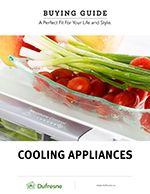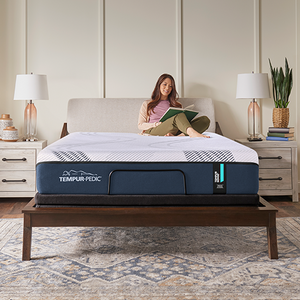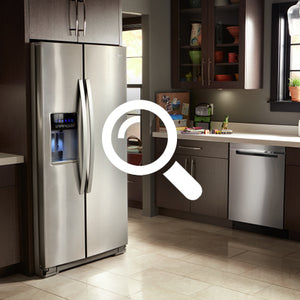Refrigeration Buying Guide
REFRIGERATION BUYING GUIDE
INTRODUCTION
The kitchen is often the heart of the home and nothing brings people together more than creating and sharing a meal. Refrigeration plays a big part in storing our food before and after meals. Its main function is to keep our food fresher for a longer period of time. This buying guide will help you identify features and options to help you make your buying decision.
HOW DO I KNOW WHAT SIZE REFRIGERATOR I NEED?
Before you go out and buy a new fridge, it’s helpful to ask yourself some basic questions.
HOW BIG IS THE FRIDGE OPENING IN MY KITCHEN?
You will need to measure the height, width and depth of the opening where your fridge is located. Take into consideration baseboards, chair rails, raised floors and uneven surfaces. If you are choosing a kitchen package, always start with the fridge as range and dishwasher sizes are consistent.
WHAT SIZE OF FRIDGE DO I NEED?
The size of fridge you need is directly related to your lifestyle. If this is your main fridge, consider how many people are in your home, how often you entertain and if you will need to store additional food. How often do you shop for groceries? Do you buy frequently in order to have fresher food or are you a bargain hunter who likes to shop in bulk?
HOW MANY PEOPLE IN A CUBIC FOOT?
A rule of thumb to calculate is approximately 10 cu ft. for 2 people, plus 1.5 cu ft. for each additional person.
COMMON EXAMPLES TO THE VARIATION:
- Allow at least 12 cu ft. for a couple that doesn’t cook a lot.
- Allow at least 16 cu ft. for a couple that does a lot of cooking or entertaining.
- Allow at least 20 cu ft. for a family of 4.
WHAT STYLE DO I NEED?
When we talk about Style of refrigerator, we are not talking about colour or finish, but how your kitchen is constructed. Refrigeration appliances come in two main styles – freestanding and built-in. Other styles are just variations.
MEASURE, MEASURE, MEASURE
A rule of thumb to calculate is approximately 10 cu. ft. for 2 people, plus 1.5 cu ft. for each additional person. Even though you calculate that your family requires a 22 cu ft. fridge, a 33” wide fridge will not fit through a 32” doorway. What do you need to measure to get an accurate reading of whether your new fridge will fit in your house? Here are some measurement criteria to think about.
VENTILATION
You need to allow for proper ventilation with at least 1” of space around the appliance. The unit may use more electricity, overheat, or in a worst case scenario, have components like the motor or compressor fail if there isn’t sufficient air flow.
DOORS
Look at the space required to open the refrigerator door. To fully access and open drawers and bins, your door must be at least at a 90 degree angle. Does the door make contact with other appliances, kitchen cabinetry or an island when you open it? You should allow 2” of additional space for the side of the door hinge. If you have a single door, should it swing to the left or to the right? If you have multiple doors, such as French doors or side-by-side, is there enough clearance when all doors are open?
HALLWAY DIMENSIONS
Getting your appliance through the outside door is only half the battle. It’s best to consider the interior requirements as well.
- Does the appliance need to go up or down a set of stairs and, if so, are there stair railings that get in the way and require removal?
- Is there enough clearance when you turn corners?
- Is there enough room at all points of the pathway from the outside door to the kitchen?
- Is there enough room to unpack the refrigerator out of the box within the kitchen?
- Does the old appliance need to be moved out of the kitchen first?
FREESTANDING
Freestanding are the most common refrigerators. These are self-contained units. All you have to do is slide them in and plug them into the wall. Refrigerator designs have changed dramatically over the last decade. Where a single door was the norm, you can now select a fridge with 2, 3, 4 and even 5 doors, depending on the model. Let’s take a closer look at today’s popular designs.
TOP FREEZER
This has been the traditional design of refrigerators since the 1940s when units had a single door with the freezer compartment located inside on the top and refrigerator compartment on the bottom. During the 1960s, the style changed to have a separate door for the freezer compartment thus making the 2-door fridge the industry standard we see today.
BOTTOM FREEZER
This is basically the inverse of the top freezer model. The main benefit with having the freezer on the bottom is that it provides easier access to your fresh foods which are usually accessed more frequently than freezer goods.
FRENCH DOOR
This design has been around since the 1990s and offers the best of both worlds by incorporating side-by-side and bottom freezer configurations in a 3-door setting. Also available is the 4-door design where a second drawer is positioned between the top doors and the bottom freezer. The additional drawer can be used as a freezer compartment or a refrigerator compartment.
COUNTER-DEPTH
Most freestanding refrigerators have a deeper profile than the depth of a kitchen cabinet, and they tend to stick out. The counter-depth refrigerator was introduced to provide a sleeker design to blend in with cabinetry. This style comes in both side-by-side and French door designs, however keep in mind that because of the shallower depth, it will have less capacity than a freestanding unit. You may want to consider a wider model if your kitchen has the space available.
FREEZERLESS
This design is probably the least common, but allows for the greatest storage of fresh food. Because there is no freezer unit at all, you want to ensure that you have other alternatives such as a full-size freezer or a second fridge if you require freezer capacity.
BUILT-INS
Refrigerators do not have finished sides like freestanding models and are designed to slide into spaces of your kitchen cabinetry. These units vary from 24"-60" wide, can have a capacity of up to 40 cu.ft. and are available in many door configurations. The main attraction of a built-in is that you can order it with custom panels that blend into the décor of your kitchen.
IS COLOUR IMPORTANT TO YOU?
Consider what exterior colour you want your refrigerator to be & whether or not you’d like it to match your other appliances. You can choose from shades of white, black/grey, stainless steel, stainless-look and custom panel options. Stainless steel is a non-magnetic surface and is more difficult to keep clean, especially from fingerprints. Stainless-look has a magnetic surface and is easier to clean. Custom panel refrigerators allow you to attach an insert that makes it look like your existing kitchen cabinets which allow for seamless integration within your kitchen space.
WHAT TYPE OF FEATURES SHOULD I BE CONSIDERING?
HUMIDITY CONTROLS
Humidity plays an important factor in our lives. Too much humidity on a hot summer day can make us sweat and feel uncomfortable. Too much humidity or not enough humidity in your refrigerator and freezer can also affect the quality of your food. Too much moisture can result in food spoilage. Having a refrigerator with a dual evaporation system allows you control your refrigerator and freezer humidity independently. Look for models that have humidity-controlled crispers and separate deli meat drawers as well as a frost-free defrosting system which limits moisture build-up.
MAINTENANCE AND FLEXIBILITY
Spills and mishaps are bound to happen in your fridge, and we all have those hard to fit items that have to go on a certain shelf. Shelving design and flexible door containers will help you with these. Shelves are made of many materials including wire, stainless steel, plastic and glass. Having spill-proof shelves will save you time and frustration for those accidental spills. Having shelves that are sliding or adjustable instead of fixed allow you to easily arrange items. Having the interior door designed to accommodate a gallon of milk saves valuable shelve space. Look for models that offer modular designs that can move or stack drawers and bins in different configurations.
OPEN DOOR ALARM
How many times have you found that the refrigerator door was left open? Consider a model with a door lock or an Open-Door Alarm – it will let you know when someone has left the door open. It also saves electricity.
LIGHTING
Many of today’s refrigerators use LED lighting which brightens up the interior of your fridge and makes it easier to find food items.
ICE AND WATER DISPENSERS
Ice Dispensers –There are three different ways of automatically dispensing ice from your refrigerator depending on the model.
- In-Freezer – From inside the freezer, you can easily access ice from your built-in ice maker. No fuss, no muss. Although it provides more ice capacity than the In-Door units, it also takes up valuable space in your freezer. This option is available on most refrigerators.
- In-Door – This option is only available on Side-by-Side and French Door units. All you need to do is press a lever on the outside of the door to dispense your ice.
- Dual Ice Maker – This is the best of both worlds where you have an In-Freezer and In-Door unit to give you extra ice making capacity, which is great for entertaining or events.
Just add water. How do you get water to your Ice/Water Dispenser capable fridge? If your current fridge does not have a water line connected to it, you will need a plumber to install a new water line to your fridge location. In addition, we highly recommend that you have proper water filtration built-in to ensure clean and safe water.

























